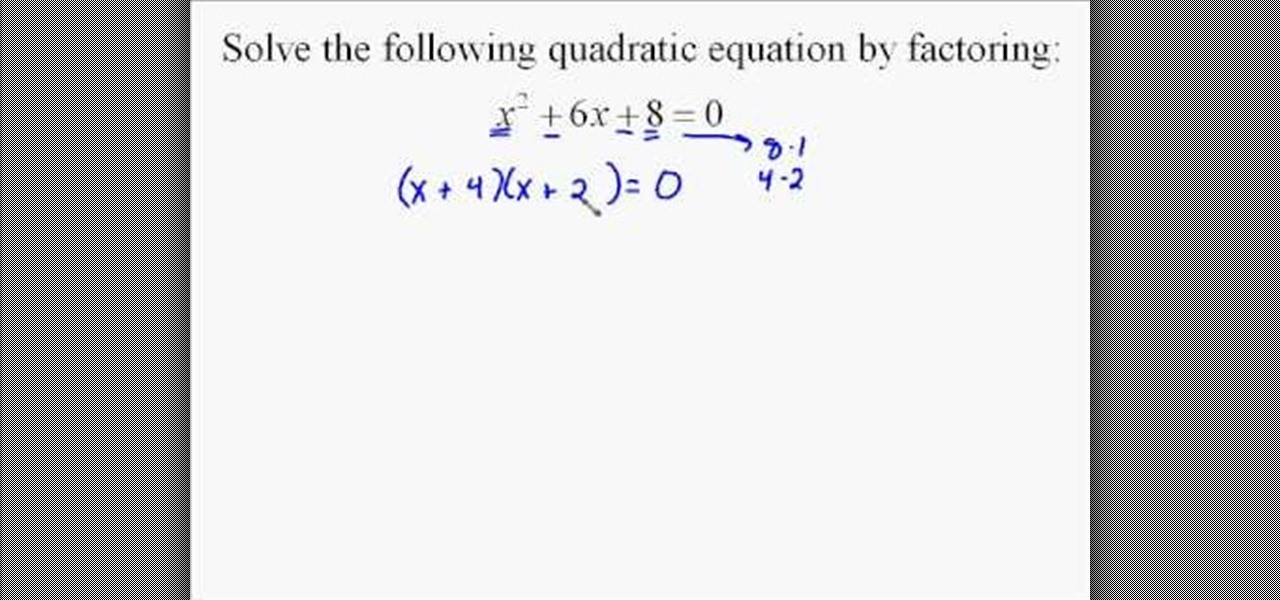
FACTOR FX EQUATION CALCULATOR CODE
However, I have fixed the code since I last posted it and now it seems to be working flawlessly.

FACTOR FX EQUATION CALCULATOR PLUS
The issue you're seeing is that it wasn't formated for the TI 84 Plus CE's screen, it was for the regular TI 84+. Soooo, turns out - my code was riddled with issues (it was super annoying to trouble shoot). I did have some trouble with the original poster's code, so I had to do some modifications, but this seems to be exactly what I wanted. If there is a common factor (G), they're dividing the coefficients by the common factor to get a reduced-form quadratic gcd(abs(A),gcd(abs(B),abs(C)))→G If G≠0:Then (A/G)→A (B/G)→B (C/G)→C End // This is my checking to see if the problem is a difference of squares problem since for some reason the original poster's code didn't seem to account for that (and I don't 100% the loops/code he/she used so I just accounted for it on my own) If fPart(√(A))=0 and B=0 and fPart(√(abs(C)))=0:Then √(A)→A √(abs(C))→C Text(1,1,0,"Factored Form") Text(1,15,0,G,"(",A,"X+",C,")(",A,"X-",C,")") Text(1,30,0,"2 Real Roots") Text(1,40,0,"X1 = ",C,"/",A) Text(1,50,0,"X2 = ",C,"/",A) Pause :ClrHome:AxesOn Stop End // This is more of the original poster's code, I only partially understand it so I'll save you all a poor explanation (A*C)→D 0→L 1→J While L≠B (D/J)→K If fPart(K)=0:Then J+K→L J+1→J Else J+1→J End End J-1→J A→O // We're almost done, this is just some more reducing to eliminate the chance that the factored form might not be fully reduced gcd(abs(K),abs(O))→H (K/H)→K (O/H)→H gcd(abs(J),abs(A))→M (J/M)→J (A/M)→A // This is my modified output to simply give the factored form of the quadratic. He's simply seeing if all the terms reduce by some common factor. While this isn't a requirement for being factorable, this program was written for students taking the ACT and that rule does apply to the test, so for it's intended purpose - it works great, however, if you have a discriminant that's a perfect square, but isn't an integer (like 1/4), then the program will just loop forever and you'll have to press "ON" to make it stop If fPart(√(B²-4*A*C))≠0:Then B²-4AC→D (B+√(D))/(2A)→K (B-√(D))/(2A)→J Text(1,1,0,"Not Factorable") Text(1,20,0,"Solutions:") Text(1,30,0,"X1 = ",round(K,5)) Text(1,40,0,"X2 = ",round(J,5)) Pause :ClrHome:AxesOn Stop End // This is the start of the original poster's code. It's set to pause on the final output so you can read the results, simply press to clear the screen. If the discriminant (B²-4*A*C) is negative, then it'll do the Quadratic Formula and display the solutions rounded to two decimal places (the rounding is just for formatting purposes, if you have the TI84 Plus CE you can let it round to a higher value). Enjoy! = Comments will be denoted with "//.", make sure you don't type those parts into your program, they're just there to help you understand what everything means = // This first block of code lays out the general setup (basically preparing the output to look pretty) ClrHome AxesOff PlotsOff GridOff FnOff ClrDraw // This block prompts the user for input and saves the variables Disp " Quadratic"," Solver","" Disp "AX²+BX+C=0","" Input "A = ",A Input "B = ",B Input "C = ",C ClrHome // This block is checking to see if the solutions will be imaginary/complex. If you try to copy/paste it, you might get some errors, but if you simply retype it line for line it should work out fine :). I'll post the code here in case it's helpful for anyone. For those who're curious, I typed the program using the TI Connect CE Software, and I transferred it to my calculator w/ the USB cord.

I've added scripts to account for complex solutions, unfactorable quadratics, and solving differences of squares problems (which for some reason the original code didn't seem to do for me). I've taken what you've done and (I think?) perfected it. I'm just dropping by to say thanks to the original poster for giving me the framework to create an awesome program.


 0 kommentar(er)
0 kommentar(er)
